Submitted by Roger Clark
The first known written account of a parachute concept is found in da Vinci’s notebooks (cl495). The sketch he drew consisted of a cloth material pulled tightly over a rigid pyramidal structure. Although da Vinci never made the device, he is given credit for the concept of lowering man to the earth safely using a maximum drag decelerator.
Fauste Veranzio constructed a device similar to da Vinci’s drawing and jumped from a tower in Venice in 1617. Over a century would pass before further developments would be made by the famous balloonists, Joseph and Jacques Montgolfier. In 1783 they succeeded in lowering animals to the ground from rooftops or balloons. During the same year Sebastian Lenormand jumped from a tower using a 14-foot diameter parachute. The first emergency use of a parachute was made by Jean Pierre Blanchard in 1785 after the hotair balloon he was in exploded. Blanchard also worked on a foldable silk parachute, for until then all parachutes were constructed with a rigid frame.
In 1797, Andrew Garnerin made the first jump with a parachute without a rigid frame. One of Garnerin’s balloon jumps from 8000 feet, a very high altitude for the time, was observed by a French astronomer, Lalandes. As the parachute descended, severe oscillations were induced in the canopy. Lalandes suggested cutting a small hole near the apex of the canopy to inhibit the oscillations. This modification is now known as the vent and does indeed dramatically reduce canopy oscillations.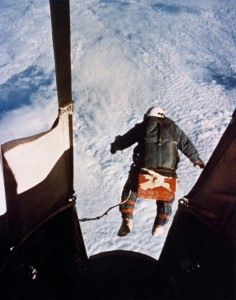
Joseph Kittinger On August 16, 1960, he made the final jump, from the Excelsior III, at 102,800 feet (31,300 m)
Felix Baumgartner broke the speed of sound reaching an estimated speed of *833.9 mph (1,342.8 km/h) jumping from the stratosphere, which when certified will make him the first man to break the speed of sound in freefall while delivering valuable data for future space exploration.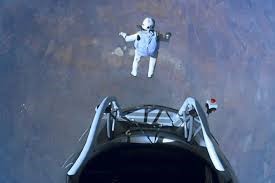
Felix climbed to 128,100 feet (39,045 meters) in a helium-filled balloon Sunday morning Oct. 14, 2012. This is exactly 65 years after Chuck Yeager first broke the sound barrier flying in an experimental rocket powered airplane. Felix broke two other world records (highest freefall, highest manned balloon flight), leaving the longest freefall record to project mentor Col. Joe Kittinger.
Even Google is getting into the act: http://www.dailymail.co.uk/sciencetech/article-2806972/Google-Executive-breaks-Felix-Baumgartner-s-highest-parachute-jump-record-secret-135-000-foot-leap-edge-space.html
Now, nobody I know has ever reached such heights, but parachute drops are well within the flight envelope of our balloons. On May 30th and 31st of this year, Glen O’Bryan and I dropped a number of parachutists from AX-7 balloons during the Carolina Fest Boogie at Skydive Carolina in Chester, SC.
Dropping parachutists takes a lot of preparation, briefing and communication. It is not your normal pleasure flight. First of all there are extra rules! FAR Part 91 and 105 both contain regulations that are required for these operations. You, as the pilot, are responsible for making sure that the parachutes being used are current. Each parachute should have a packing data card showing the last 180 day inspection date. Reserve parachutes must be repacked annually.
Even parachutists have their own rules: https://www.law.cornell.edu/cfr/text/14/part-65/subpart-F
The United States Parachute Association also maintains a comprehensive guide for sport parachuting: http://www.uspa.org/USPAMembers/Downloads/tabid/84/Default.aspx
You also need to check your manufacturers Flight Manual. I have examples from Cameron and Kubicek where they have very specific limitations and procedures for dropping parachutists. The weight of the passengers and their equipment must be taken into account for accurate flight planning.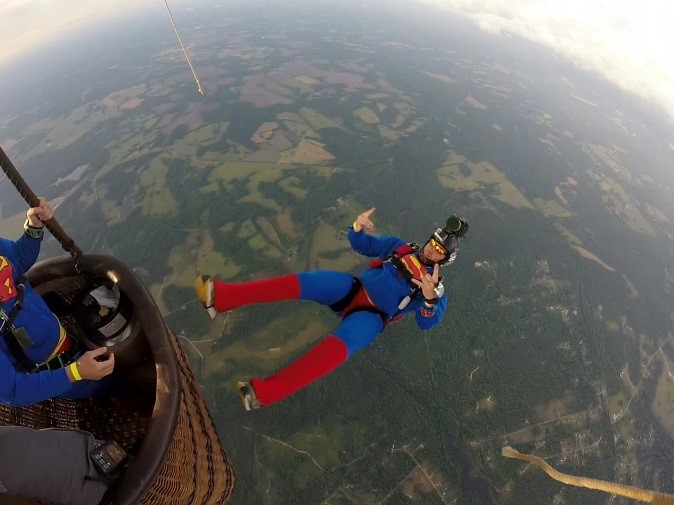
Kubicek recommends the following procedure:
- Preparation – Parachutists sit on the basket edge
- Clean Exit – Parachutists are well free from control lines, fuel hoses and any other equipment
- Airspace Check – Airspace under the basket is free from any air traffic
- Dropping – Parachutists leave the basket after the agreed pilot’s signal
- Vent – Open the parachute and hold it open until necessary
All of these steps should be discussed in detail with the jumpers before the flight has begun. I generally have the jumper stand on the side of the basket or in the step hole on the side of the basket for a clean release. I do not generally use the valve since I have established a good descent and do not drop more than one jumper at a time. I also make sure that I give the final clearance to leave the basket after I have confirmed descent rate, clearance below and that the jumper is not near anything the might snag or tangle them with the balloon.
Just like ballooning, maintain good landowner relations and finding good landing spots are critical to our continued sports. Working with the jumpers to identify good places to land (off airport if necessary) is very important. Power lines are their enemy as well.
Most jumpers will want to go to 5,000 – 6,000 feet for their jumps. We had one jump from 4,500 during the weekend and I have had jumpers go out as low as 1,000 feet. This is a good time for a reminder: Your insurance will NOT cover a jumper if they are injured. (This has been confirmed with Schantz and IMC). Furthermore, if there is damage to anything on the ground or the balloon, you are not covered for liability is most, if not all, cases. *Check your policy.
As you can see from the photo below, I was descending from 6,000 feet for my first jump and had achieved 500 fpm down. The first jumper was released and then I waited for the balloon to achieve 500 fpm down before allowing the second jumper out. After that, it is basically a controlled terminal descent back to the ground to pick up a second hop of jumpers or find a landing place.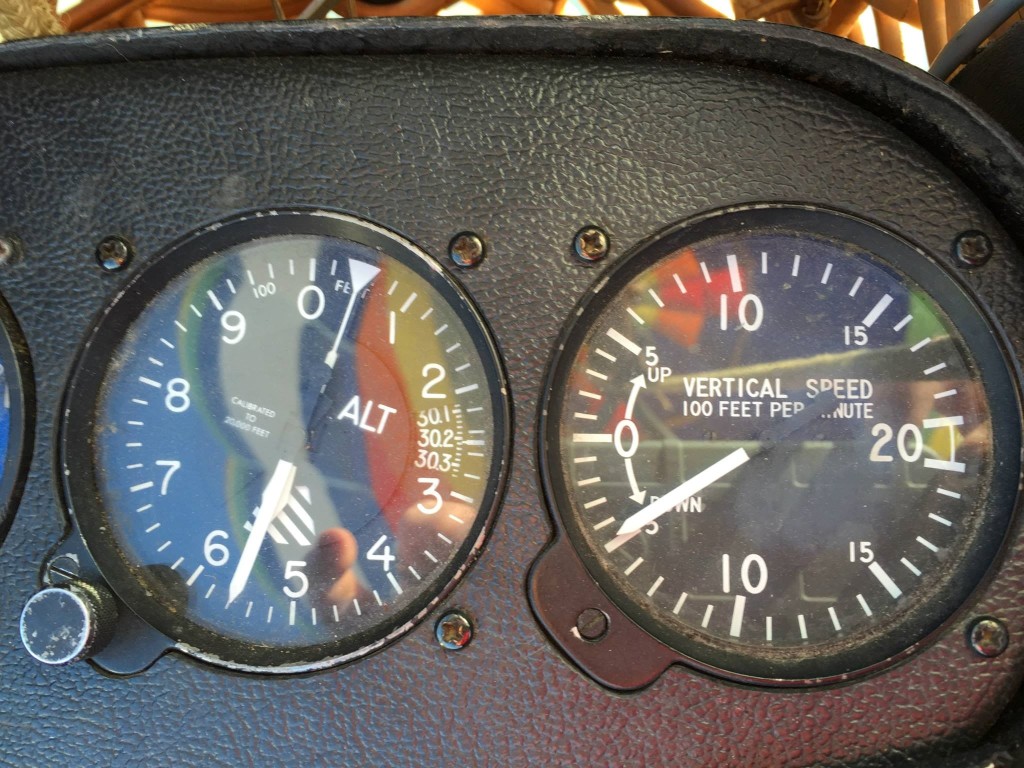
Depending on the size of you balloon, the number of jumpers, the temperature and the altitude they want to jump from, plan to burn at least one tank for climb to altitude. You will be burning much more than normal to maintain a good rate of ascent while keeping the jumpers in a good range of their landing zone. I have experienced fuel burn rates of double the normal during climb for jump flights.
The first arrow below is the peak of the climb. The second arrow is just after the first drop. The third arrow is the top of the rebound climb. The second jumper went out on the second descent.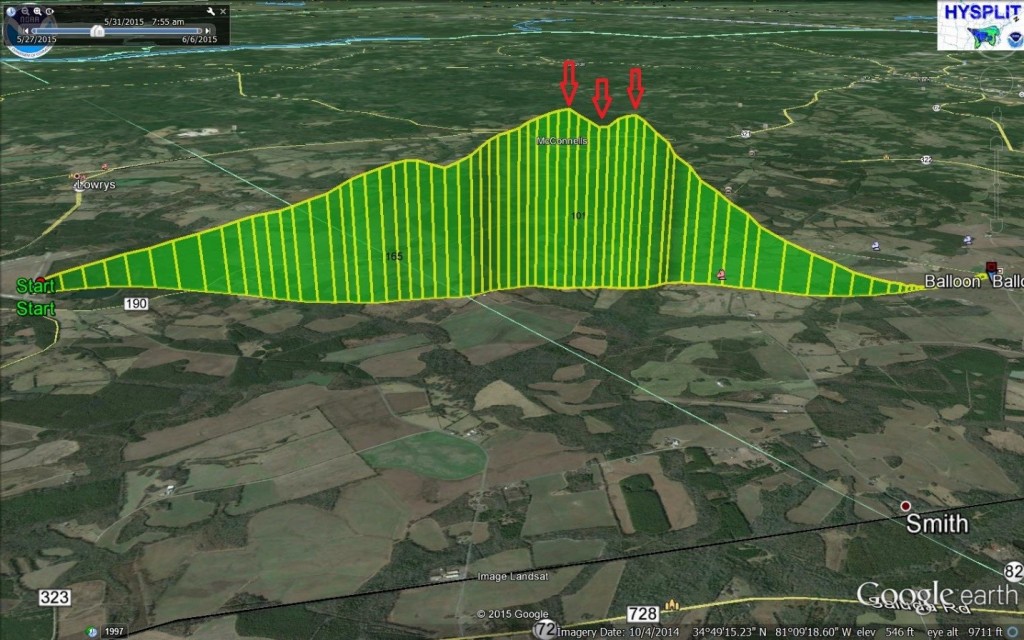
This type of activity is not for everyone and entails a different level of risk from our normal operations. If you would like to do this, please seek out someone who has done it before and have a good conversation about the procedures, risks and rewards before going off on your own. With proper planning, training and communication dropping parachutists can be a fun and rewarding addition to your ballooning resume. I have attached a link below of the videos we shot during the weekend. You will get to see the communication and effort that goes into a safe and successful drop.
FYI – The British Parachute Association actually has a semi-annual licensing for balloon pilots wishing to drop parachutists.
Videos of all of the jumps I dropped: https://www.dropbox.com/sh/foxnde22joyrj8v/AAAXiILfd2uvoenBArMEcZPAa?dl=0
